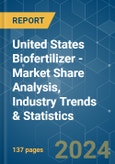The United States Biofertilizer Market size is estimated at USD 0.57 billion in 2024, and is expected to reach USD 1.04 billion by 2029, growing at a CAGR of 12.78% during the forecast period (2024-2029).
Key Highlights
- Rhizobium is the Largest Form : Rhizobium is mainly because it is a vital source of nitrogen to the majority of agricultural soils, which can fix nitrogen ranging from 200 to 300 kilograms annually.
- Rhizobium is the Fastest-growing Form : The rhizobium based biofertilizers have the ability to reduce the overall dependence on chemical fertilizers, by reducing the total cost of production for farmers.
- Row Crops is the Largest Crop Type : The most popular biofertilizers applied to cereals are those based on Rhizobium, Azotobacter, Azospirillum, and Cyanobacteria. Which have shown a positive yield responses.
- Row Crops is the Fastest-growing Crop Type : The growing trend of row crop value is mainly due to increasing trend in therow crop cultivation area, it has increased by about 24.9% during the period between 2017 to 2021.
US Bio Fertilizers Market Trends
Rhizobium is the largest Form
- Biofertilizers are organic substances with living microorganisms that promote plant growth. The biofertilizer market value increased by about 49.1% during the historical period (between 2017 and 2022), which was attributed to various reasons like increasing awareness among farmers, increasing the overall registered organic farms in the United States, and a shift in demand for organically or sustainably grown commodities.
- An overall increasing trend is observed in the biofertilizer market both in terms of value and volume due to increasing demand for biofertilizers in the country.
- Rhizobium biofertilizer has the largest market share compared to other biofertilizers. It is anticipated to increase its market share further during the forecast period.
- Mycorrhiza occupied the second-largest market share in the biofertilizer market, followed by Rhizobium, and accounted for about 26.4% of the total market value in 2022. It was followed by Azospirillum, which accounted for 24.4% of the total biofertilizer market value in 2022.
- Continuous research is being conducted to develop strains that are biotic/abiotic stress tolerant. For instance, under salinity stress, Rhizobium trifolii inoculated with Trifoliumalexandrinum showed increased biomass and nodulation. Positive research findings and the presence of active companies in this segment are likely to drive the biofertilizer market to a large extent during the forecast period.
- The increasing awareness about the overuse of fertilizers among farmers and the government initiatives to support sustainable agricultural practices and organic farming resulted in a growing demand for biofertilizers. Therefore, the US biofertilizer market is anticipated to increase during the forecast period.
US Bio Fertilizers Industry Overview
The United States Biofertilizer Market is fragmented, with the top five companies occupying 22.98%. The major players in this market are Kula Bio Inc., Novozymes, Rizobacter, Suståne Natural Fertilizer Inc. and Symborg Inc. (sorted alphabetically).Additional Benefits:
- The market estimate (ME) sheet in Excel format
- 3 months of analyst support
Table of Contents
1 EXECUTIVE SUMMARY & KEY FINDINGS2 REPORT OFFERS7 KEY STRATEGIC QUESTIONS FOR AGRICULTURAL BIOLOGICALS CEOS
3 INTRODUCTION
4 KEY INDUSTRY TRENDS
5 MARKET SEGMENTATION
6 COMPETITIVE LANDSCAPE
8 APPENDIX
Companies Mentioned (Partial List)
A selection of companies mentioned in this report includes, but is not limited to:
- AgroLiquid
- Indogulf BioAg LLC (Biotech Division of Indogulf Company)
- Koppert Biological Systems Inc.
- Kula Bio Inc.
- Lallemand Inc.
- Novozymes
- Rizobacter
- Suståne Natural Fertilizer Inc.
- Symborg Inc.
- The Andersons Inc.
Methodology

LOADING...









